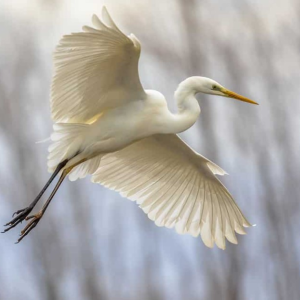An immense communal effort, continental connections, and exotic materials travelling long distances for people to gather and marvel at: this could be a summary of the story of Stonehenge, but it also describes the creation of a new exhibition opening at the British Museum this month, and the challenges of arranging hundreds of international loans during a pandemic. Organised with the State Museum of Prehistory, Halle/Saale, Germany, and developed with Professor Duncan Garrow at the University of Reading, The World of Stonehenge places the monument in its wider context, exploring the natural and material landscapes that its builders would have known; the technological, cultural, and social changes it witnessed over 1,500 years (and the dramatic changes the monument itself underwent); and the ideas it expressed.

Over the course of 1,500 years, Stonehenge witnessed dramatic changes, both to its own design and within the cultural landscape of prehistoric Britain. Photo: English Heritage.
It is a story that begins millennia before the first elements of Stonehenge took shape, towards the end of the last Ice Age when the lands that would become Britain were inhospitably cold and long abandoned by early humans. As temperatures began to rise some 15,000 years ago, intrepid hunter-gatherers ventured back across what is now the English Channel, following herds of horse, reindeer, and bison over a wide plain – now known as Doggerland – that formed a bridge to continental Europe until it was lost to the rising waters of the North Sea c.8,000 years ago. These would have initially been seasonal hunting expeditions, but some of these nomadic communities stayed, and began to leave lasting traces in the landscape.
On Salisbury Plain, just 250m from where the first phase of Stonehenge would be built 5,000 years later, Mesolithic people dug great pits and raised tall timbers whose traces were rediscovered in 1966 during the expansion of a car park built for modern visitors to the site. Whether these 10,000-year-old posts were erected as utilitarian markers or elaborately carved totems is unknown, as their timbers do not survive, but they suggest that the site was recognised as special in some way from a very early date – and hint at people putting their own stamp on the landscape before Britain had become an island, an early expression of permanence in a still very mobile world.
Living with the landscape
The lives of Mesolithic hunter-gatherers were intimately entwined with the landscapes that they moved through. Knowing how to find water, how to track animals, and what plants were good to eat or practically useful could literally be a matter of life and death when food supplies were seasonal and sometimes precarious. They may have understood their relationship with the natural world as a reciprocal and placatory one, and a possible reflection of such beliefs lies 250 miles to the north, beside a now-vanished lake in the Vale of Pickering that became a fascinating focus of activity during the period when the ‘car-park posts’ were being erected on Salisbury Plain. Star Carr represents, if not a settlement, then a more persistent place in the landscape, and the wooden platforms and simple structures created by its occupants have been preserved by the anaerobic conditions of the lake shore (see CA 282 and 349).

One of 33 red-deer ‘frontlets’ excavated at Star Carr, a Mesolithic site in North Yorkshire.
Many artefacts from the site illuminate aspects of everyday life, but some are more enigmatic, none more so than 33 ‘frontlets’. Crafted from the tops of red-deer skulls, these are interpreted as some kind of headdress, possibly worn in shamanic ceremonies, and one is included in the British Museum exhibition. An intriguing continental counterpart, also among the displays, comes from the burial of a woman discovered near Halle in Germany in 1934. She had been interred around 8,500 years ago, when lakeside activity was still flourishing at Star Carr, and her grave goods include red-deer antlers, as well as numerous tusks, teeth, and bones from other wild species, that may have formed part of an elaborate headdress.

This polished jadeitite axe is made of materials quarried in the Italian Alps.
Covered in red ochre and buried upright in a crouched position, accompanied by a baby, this figure has been dubbed the ‘Bad Dürrenberg shaman’ because of the objects buried with her – but there are also physical clues to why she may have been perceived as special. An unusual deformation at the base of her skull and the top of her spine would have possibly caused auditory and visual hallucinations, and a tendency to faint or enter a trance-like state when she turned her head. This change of consciousness, possibly accessed at will, could have been associated with an ability to travel through other worlds or commune with wild animals or supernatural forces.
Returning to the Stonehenge landscape, evidence of more lasting connections with specific places is found at Blick Mead, c.1.5 miles from the site of Stonehenge. Beginning c.9,500 years ago, large groups of people seem to have gathered beside a spring, to hunt giant cattle known as aurochsen and share the spoils. Tens of thousands of flint tools reflecting repeated visits, as well as quantities of burnt animal-bone testifying to lavish feasts, have been excavated at the site since 2005 (see CA 271, 324, 325, and 381). It took outside influences for more formal settlements to evolve in Britain, however – influences that brought seismic changes.
Living in a material world
Around 6,000 years ago, incomers from mainland Europe brought transformative new ideas and technologies to Britain, including the domestication of livestock, the cultivation of crops, and pottery-production – changes associated with the Neolithic period. The rise of agriculture heralded permanent settlements and a more reliable food supply, which may have also brought a change of mindset: ownership of land meant territory to defend, animals that needed to be protected and could be counted as wealth, and perhaps new ideas of status and identity tied to what you owned. Neolithic Britons were now living in a material world, with more substantial structures reflecting greater investment in houses and a less mobile lifestyle meaning that possessions did not need to be limited to what you could easily carry.

The Neolithic heralded the construction of permanent dwellings, including substantial stone buildings like those at Skara Brae in Orkney. Photo: Reading Tom, CC BY 2.0.
The impact of these early farmers on the landscape was on a completely different scale to their predecessors. Pollen analysis paints a picture of significant tree-clearance, and the tool most associated with this change is the axe. The displays ‘really go to town’ on this artefact, exhibition lead curator Dr Neil Wilkin says, with a wall of 90 polished stone axes from different parts of Europe during different parts of the Neolithic. Each artefact stands for a generation within the Neolithic, and their finely polished surfaces, representing hours of gruelling work with sand and water, also highlight that these were not just utilitarian tools, but prized and carefully worked artefacts, some of which had travelled long distances.
Among the displays are jadeitite examples from the Italian Alps, and grey-green Langdale stone from Cumbria, both harvested from high peaks that may in themselves have been perceived as spiritually important places. Another key artefact within this section is a hafted axe from Shulishader on Lewis in the Outer Hebrides. Dating to 3495-2910 BC, it was recovered from peat which had preserved its wooden handle almost intact – a rare survival that reminds us that these were not hand axes, but were mounted like their modern equivalents.
Monumental changes
It was not only through farming that Neolithic people left their mark on the landscape. They also created deep flint-mines like Grimes Graves and dug quarries to harvest stone for their constructions (although stone extraction itself has earlier origins), while wooden trackways criss-crossed watery areas to give access to these liminal spaces. Timbers from one c.5,200-year-old example, the Sweet Track, which was found near Glastonbury, are included in the exhibition, and such paths of planks seem to have acted as platforms from which to commit artefacts, possibly votive offerings, to the boggy waters.

Part of the Sweet Track, a Neolithic pathway that once allowed access into the Avalon Marshes near Glastonbury.
Perhaps the most dramatic and enduring modification of people’s surroundings, though, was the rise of imposing monuments in wood and stone. From causewayed enclosures and circular arrangements of uprights to chambered tombs and long cairns, these constructions scattered the land, sometimes forming ceremonial landscapes in their own right, such as the Brú na Bóinne complex in Co. Meath, and the remarkable range of monuments around Brodgar and Stenness in Orkney. Stonehenge too was surrounded by monuments, though today it appears isolated, and many of them seem to have been built on astronomical alignments. Winterbourne Barrow, for example, which stands around 1.5 miles from Stonehenge and pre-dates it by c.500 years, is thought to be aligned on the midsummer solstice sunrise. Objects from this tomb are included in the exhibition, as are artefacts from another more recently excavated Salisbury Plain monument, that of Larkhill (see CA 326). This latter site, a causewayed enclosure dating to c.3750-3650 BC, is one of the earliest known monuments in the Stonehenge landscape, and is also carefully aligned on the midsummer solstice. Further afield, the midwinter sun seems to have played a key role in the design of the passage tombs at Newgrange in Co. Meath, and Maeshowe in Orkney, with light spilling into their central chambers at the solstice.

A carved stone from Structure 10 at the Ness of Brodgar (the wider site is shown below). Similar geometric designs are found across Britain and Ireland on a range of materials, constructions, and objects. PHOTO: ORCA.

Photo: Hugo Anderson-Whymark.
Stonehenge itself began as a ditched and banked circuit c.5,000 years ago, and its first stones were brought an impressively long distance to form the next phase of the monument. A series of pits known as the Aubrey Holes are thought to represent the original setting of the bluestones, small geologically exotic uprights that were brought from the Preseli Hills in west Wales (CA 366, 345, and 311 – and once these stones were moved to their present arrangement, the site became an early cremation cemetery, with many of the burnt remains placed in the upper fills of the vacant stone-holes. Significantly, analysis of the burnt bone and charcoal suggests that some of these individuals had died and been cremated in west Wales too. The monument was already 500 years old when it gained its now-familiar sarsen uprights and trilithons; unlike the bluestones, these were of local material quarried in the West Woods area of the Marlborough Downs, around 20 miles north of Stonehenge (CA 367).
While monuments were built across the British Isles, an intriguing picture of shared artistic ideas also emerged in the later Neolithic period (c.3000-2500 BC). Here we see the first appearance of Grooved Ware pottery, with its distinctive geometric designs, first in Orkney but soon spreading throughout Britain and Ireland. A shared repertoire of abstract chevrons, zigzags, and spirals developed, seen both on the walls of fixed structures like the Newgrange passage tomb and the stone ‘houses’ at Skara Brae and the Ness of Brodgar in Orkney, and on portable objects. These artefacts are not limited to pottery like the decorated sherd from Skara Brae that is on display, but are an eclectic range of objects including intricately carved stone balls (mostly from Scotland), the unique ceremonial macehead found within the great passage tomb at Knowth, Co. Meath, and the Folkton Drums, three chalk cylinders found in a child’s grave in North Yorkshire.

The Folkton Drums, found in a Neolithic child’s grave in North Yorkshire.
This wide geographical sweep, together with the expression of similar motifs across a varied range of materials, and on objects and structures associated with both the living and the dead, suggests that these symbols were readily understood and had a deep significance for the people who carved and observed them, although their meaning has been lost to us. The British Museum displays include numerous examples of this artwork, including carved stones from the Ness of Brodgar that have never left Orkney before. Neolithic artists were not incapable of producing figurative images, however: the swirling designs of the Knowth macehead and the Folkton Drums have been interpreted as possible depictions of faces.

Seahenge, pictured in 1999, shortly after its discovery on the north Norfolk coast. Some of its timbers have come to the British Museum exhibition from Lynn Museum. Photo: Wendy George
Here comes the sun
Unsurprisingly, no part of Stonehenge itself appears in the exhibition, but another prehistoric monument has made the journey to London: Seahenge, which was discovered on the Norfolk coast at Holme-next-the-Sea in 1998, and has been dendrochronologically dated to 2049 BC. It was a compact oval of 55 split oak trunks, arranged with their bark facing outwards, giving the appearance of one giant tree. A narrow entrance into this circle was aligned on the midsummer sunrise, and at its heart was the striking sight of an upturned tree trunk, its roots stretching skywards like branches. Around 50% of the timber uprights, including the forked ‘doorway’ are included in the exhibition, with the entrance aligned on a light installation evoking the rising and setting sun.
Timber monuments like Seahenge were an important part of the ceremonial landscape – concentric circles of posts once stood close to Durrington Walls, near Stonehenge, for example – although, unlike their stone neighbours, they do not tend to survive. Seahenge is a rare exception to this rule – and an illuminating combination both of a thoroughly Neolithic tradition, and of huge technological changes that had arrived in Britain around 500 years before it was built. Marks on the surface of its posts attest that its timbers were felled and shaped using metal axes.

This ornate macehead was found in the great passage tomb at Knowth and is usually displayed at the National Museum of Ireland. Photo: National Museum of Ireland.
Metalwork had flourished on the continent for c.1,000 years before it came to Britain c.2500 BC, during what is known as the Bell Beaker phenomenon (CA 338). Stone did not immediately disappear – as a series of Scandinavian flints from this period (displayed in the exhibition) attest, this was not ‘bad technology’ that was swiftly and gratefully abandoned, Project Curator Dr Jennifer Wexler said, but metal made a whole range of new tools possible. Even Stonehenge was affected by this new enthusiasm for bronze daggers and axes, as 115 images of these implements were carved into the surfaces of some of its stones c.1750-1500 BC (see CA 380 and 273).
As well as its practical advantages, the advent of metal provided a new material with which people could express artistic and religious ideas. While celestial interests persisted, there was a notable shift in how these ideas were expressed. Instead of the construction of huge solstice-aligned monuments, emphasis instead was on the creation of smaller portable objects representing or celebrating the sky. Chief among these in the displays is the Nebra Sky Disc, the earliest known representation of the cosmos, which has travelled to the UK for the first time as part of the exhibition. Found as part of a hoard of metal objects near Nebra, Germany, in 1999, the 32cm-wide bronze disc is decorated with symbols thought to depict the sun, moon, and stars. Like the wooden and stone monuments discussed above, it demonstrates deep knowledge of the skies and of alignments – it also represents a key change in cultural priorities. No more was the emphasis on collective construction efforts and communal gatherings to greet the solstice. Instead, depictions of the skies were on a much more intimate scale, and their creation was the preserve of skilled artisans. Rather than encouraging mass gatherings, they could be owned by elite individuals or select groups.

The Nebra Sky Disc is the earliest known depiction of the cosmos. IMAGE: LDA Sachsen-Anhalt, Juraj Lipták.
‘Solar’ objects in the exhibition span a wide geographical territory, from Britain and Ireland to France, Germany, and Scandinavia. They include delicate crescents of gold sheet that may have been worn as collars – they are known as ‘lunulae’ due to their moon-like shape, but their gleaming golden appearance may have instead been intended to evoke the sun. Around 80 examples are currently known from Britain and Ireland, though they have also been found in France, Iberia, Germany, and Denmark, and other gold objects on display that may have been intended to be worn in ceremonial circumstances include a pair of tall cones embellished with lines, circles, ‘solar wheels’, and sunbursts. One comes from Germany and the other from France, and, while their precise purpose is unknown, they have been interpreted as hats that may have been worn by priests or local leaders. Meanwhile, another object that might be familiar to readers of CA is a gold pendant known as the ‘Shropshire bulla’; it has close parallels with pendants known from the island of Ireland (see CA 349), and its geometric decorations have also been interpreted as solar imagery.
Wealth and warfare
From depictions of the sky, the exhibition then descends to the earth, exploring Bronze Age burials. As mentioned above, metal arrived in Britain thanks to significant migration during the Bell Beaker movement, and the individuals who held this knowledge would have been perceived as possessing almost magical skills. The burials of some of them have been discovered in the Stonehenge landscape. At this time, grave goods were increasing in importance as a way of expressing identities, aspirations, and status, and some burials suggest remarkable wealth and social importance. One, found 900m from Stonehenge, is the Bush Barrow burial, whose male occupant was laid to rest with gold and bronze objects, including a diamond-shaped plaque placed over his chest, which is included in the exhibition. Perhaps the most famous grave in the Stonehenge landscape, though, is that of the Amesbury Archer – a migrant metalworker who had the richest array of grave goods known from any Beaker burial in Europe (see p.50).

Golden finds: this lunula (sheet gold collar) from Blessington, Co. Wicklow, may reflect beliefs centred on solar imagery.

The Mold cape, found in a c.1900-1600 BC grave in Flintshire, Wales, may have been worn to convey a person’s status, possibly in a ceremonial role.
Together with a more individualised approach to solar imagery, and an increase in individual wealth, there also seems to have been a shift away from communal burials. The land around Stonehenge became scattered with barrows marking the graves of single figures – and interest in communal gatherings at the stones also seems to have waned, as from 3,500 BC no new building work occurs at the monument. Society at large was changing, with cross-Channel links becoming increasingly important, both in terms of new ideas and commercial opportunities. This trade was large-scale and organised, something reflected in shipwrecks like that found at Langdon Bay, near Dover. No remains of the ill-fated vessel had been preserved, but its cargo of scrap metal – c.360 bronze tools, weapons, and fittings, many of them fragmentary – had. It is thought that these objects were being brought from the continent to be melted down and recycled. The examples in the exhibition highlight both the sheer quantities of metal objects that were travelling to Britain, and the risks that people were prepared to take to make these journeys.

The Bush Barrow burial gold plaque. Photo: David Bukach, © Wiltshire Museum, Devizes.

Dirks are short swords, but six huge versions are known from England, France, and the Netherlands. Too big for practical use (the Oxborough dirk, c.1500-1350 BC, is 70.9cm long), were these prestige trade goods?
The importance of controlling these materials and the wealth they generated, however, may have given rise to new social stratification – and to an increase in violent interactions. The Bronze Age was, of course, the traditional setting of the Trojan War, and excavations in north-west Germany have also revealed what is thought to be one of the earliest battlefields in Europe, dating to c.1250 BC. While metal could be used to make innovative and more efficient tools, it was also used to make weapons in huge numbers, from spearheads to dirks and swords, as well as shields hammered from sheets of bronze. Such items, together with human remains bearing traces of battle trauma, bring this darker aspect of the later Bronze Age into focus, Neil said – although beautifully worked cuirasses and helmets known from France and Italy represent a more glamorous side of the Bronze Age warrior ethos. ‘It’s the sort of thing you could imagine on Brad Pitt in a depiction of the Trojan War,’ Neil said. ‘We don’t tend to imagine north-west Europe in the same terms as the Mediterranean in this period, and we don’t have epic Homeric narratives of conflicts taking place here, but evidence suggests that violent interactions were happening here too, and oral accounts must have been passed down.’

The ‘Shropshire bulla’ (47mm by 37mm) is the final object in the exhibition, encapsulating its themes of connectivity and creativity.

However, finds like this bone necklace (c.3100-2500 BC) from Skara Brae remind us that while prehistoric periods are defined by metal and stone technology, organic objects hold vital clues.
From such grand narratives, the exhibition ends on a domestic note, returning from the battlefield to the safety of the home. Among these concluding displays is material from Must Farm near Peterborough, a site whose well-preserved structures seem to have been abandoned during a fire, leaving behind undisturbed insights into Bronze Age life reminiscent of scenes aboard the Mary Celeste, with tools, personal possessions, and half-eaten meals all left in place. Alongside pottery and metalwork from the site, some of its remarkably preserved organic objects – finely worked wooden bowls and small bobbins with thread still wrapped around them – are shown in the exhibition. Organic finds like these offer particularly thought-provoking insights into British prehistory, whether in the Mesolithic, Neolithic, or Bronze Age, Neil suggested. Although we define these periods by their stone and metal technologies, more fleeting materials like wood played a key role in people’s lives throughout the span of time explored in the exhibition. They even facilitated these innovations, Neil said – you need wood charcoal for smelting, and many of the metal axes that were forged were used to cut down trees. Above all, everyday objects are vital for filling in the gaps between grand ceremonial constructions and gleaming gold: in simple things we are best able to reconstruct the world of Stonehenge.





